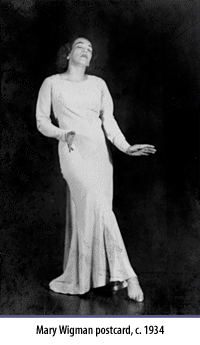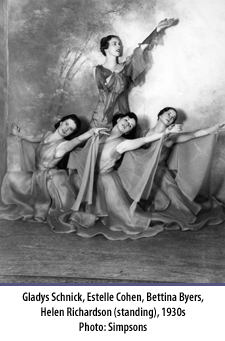| |||||||

![]()
The new year began with a to Sutcliffe from Lorna (McLean) Sheard in which she writes:
The Director of Hart House Theatre [Edgar Stone] has asked me to invite you to participate in the activities of a group now being formed, which, for want of a better name, might be called a Theatre Work-Shop.
The first meeting of this group will be held in the auditorium of the theatre at five o'clock on Wednesday, January the twenty-first. We are very much hoping to have you with us."
 This group became a children's theatre company initially called The Experimental Group, but within a year was renamed The Children Players. Their first production was Frances Hodgson Burnett's Racketty-Packetty House, which gave one show on March 28, 1931; considering that their first meeting was two months prior, it's a rather remarkable accomplishment. The performers were children including Sheard's own. Susan Goulding, a daughter of Dorothy Goulding, also performed. Soon, all the Goulding girls would be involved in The Children Players when their mother succeeded Sheard as director of the company in 1933. Sheard selected Racketty-Packetty House because of its mixture of adult and child roles. Adult performers in this show included Elaine Wodson and Betty Mitchell, who appear in numerous Hart House productions over the years as actors and dancers. The Hepburn sisters, Barbara and Betty, also performed in Racketty-Packetty House and continued to work with the group throughout the 1930s with Betty eventually becoming Goulding's assistant. Lorna Sheard directed the play and Ettore Mazzoleni played the piano. In the house program, Alison Sutcliffe is thanked for contributing her services (although the program does not explain exactly what those services were - presumably choreography).
This group became a children's theatre company initially called The Experimental Group, but within a year was renamed The Children Players. Their first production was Frances Hodgson Burnett's Racketty-Packetty House, which gave one show on March 28, 1931; considering that their first meeting was two months prior, it's a rather remarkable accomplishment. The performers were children including Sheard's own. Susan Goulding, a daughter of Dorothy Goulding, also performed. Soon, all the Goulding girls would be involved in The Children Players when their mother succeeded Sheard as director of the company in 1933. Sheard selected Racketty-Packetty House because of its mixture of adult and child roles. Adult performers in this show included Elaine Wodson and Betty Mitchell, who appear in numerous Hart House productions over the years as actors and dancers. The Hepburn sisters, Barbara and Betty, also performed in Racketty-Packetty House and continued to work with the group throughout the 1930s with Betty eventually becoming Goulding's assistant. Lorna Sheard directed the play and Ettore Mazzoleni played the piano. In the house program, Alison Sutcliffe is thanked for contributing her services (although the program does not explain exactly what those services were - presumably choreography).
On February 20, 1931, Sutcliffe attended the performance given by German Expressionist dance artist Mary Wigman at Massey Hall; she is also likely to have attended the supper party for Wigman held at the Heliconian Club following the performance. Sutcliffe was deeply inspired by Wigman and travelled to Germany to study with her a couple of times during the 1930s.
By the fall of 1931, Sutcliffe was busy with rehearsals for Kali: A Drama of India by Toronto-based writer Florence Blaisdell, and the choreography for Brer Rabbit at Hart House. Brer Rabbit, directed by Edgar Stone, was aimed at children and played in the week following Christmas. The production was well received by critics although one anonymous writer penned a cryptic comment about the choreography, "The story was adapted by Mrs. Percy Dearmer and the music, which would have done credit to more pretentious choreography, was by Martin Shaw." Lorna Sheard directed the pantomime and Ettore Mazzoleni conducted the music. Kali premiered on January 12, 1932 and was produced by the Lyceum Club, the Women's Art Association and the Canadian Dramatic Association. Sutcliffe supervised the "Dancing Girls". Four days later, another production by Lorna Sheard's Children Players opened, The Princess in the Fairy Tale, with dances by Alison Sutcliffe. For Sheard's spring production of the Children Players, A Midsummer Night's Dream, Sutcliffe also staged the dances.
 The 1932/33 season was another busy one as Sutcliffe juggled project after project in addition to her job teaching dance at the Toronto Conservatory of Music. Sutcliffe taught dance for the Conservatory from 1931-1940; here, her classes included ballet, modern and Spanish dance. In a brochure for classes c. 1934, she reveals her philosophy on ballet (including character dances) and modern training, "These two forms of the dance complement each other. It is essential that both are understood by the pupil." Her brochure advertised her teaching of "Authentic Spanish Dances - Garrotin, Jota, Sevillanas, Bulerias, Tango, etc. Use of castanets, fan and shawl." In the same document, she also elaborates on the possibilities of dancing as a career, "The successful dancer is assured of a good position, a good income, and the best of health. There is a constant demand for dancers in Opera, Concert and various kinds of stage work. Good teachers are needed. Writers and critics on the dance would find the training invaluable."
The 1932/33 season was another busy one as Sutcliffe juggled project after project in addition to her job teaching dance at the Toronto Conservatory of Music. Sutcliffe taught dance for the Conservatory from 1931-1940; here, her classes included ballet, modern and Spanish dance. In a brochure for classes c. 1934, she reveals her philosophy on ballet (including character dances) and modern training, "These two forms of the dance complement each other. It is essential that both are understood by the pupil." Her brochure advertised her teaching of "Authentic Spanish Dances - Garrotin, Jota, Sevillanas, Bulerias, Tango, etc. Use of castanets, fan and shawl." In the same document, she also elaborates on the possibilities of dancing as a career, "The successful dancer is assured of a good position, a good income, and the best of health. There is a constant demand for dancers in Opera, Concert and various kinds of stage work. Good teachers are needed. Writers and critics on the dance would find the training invaluable."
Autumn 1932 featured a "Dance Recital" with her friend Madeleine Leweck from the Metropolitan Opera Ballet, followed by a holiday production of J.M. Barrie's Peter Pan; the new year included an evening of a lecture and dramatization with the Dickens Fellowship, Melville Keay's Bits from Hits two days later, a February presentation by The Children Players, and then finally a break before a recital of her pupils in June. All but the Dickens Fellowship show were presented at Hart House.
The "Dance Recital" featured Alison Sutcliffe in several solos with guest appearances by Leweck and piano solos played by Elsie Bennett, whom Sutcliffe knew from the Toronto Conservatory of Music. The pieces reflected Sutcliffe's training to that point: ballet and Spanish dance. While Sutcliffe and Leweck performed most of the bill, there were a couple of works that featured other local dancers including Winnifred Fax, Helen Richardson, Bettina Byers and Violet Andras who appeared in Sutcliffe's Water Study, performed in silence; a critic at The Varsity described the work as "strikingly original".
![]()
©2008, Dance Collection Danse
Alison Sutcliffe Exhibition Curator: Amy Bowring
Web Design: Believe It Design Works
A Midsummer-Night's Dream,1932
Announcement for Sutcliffe's classes at the Conservatory
Brochure for Sutcliffe's classes at the Conservatory
Jean Macpherson with Barbara Hepburn and other students





